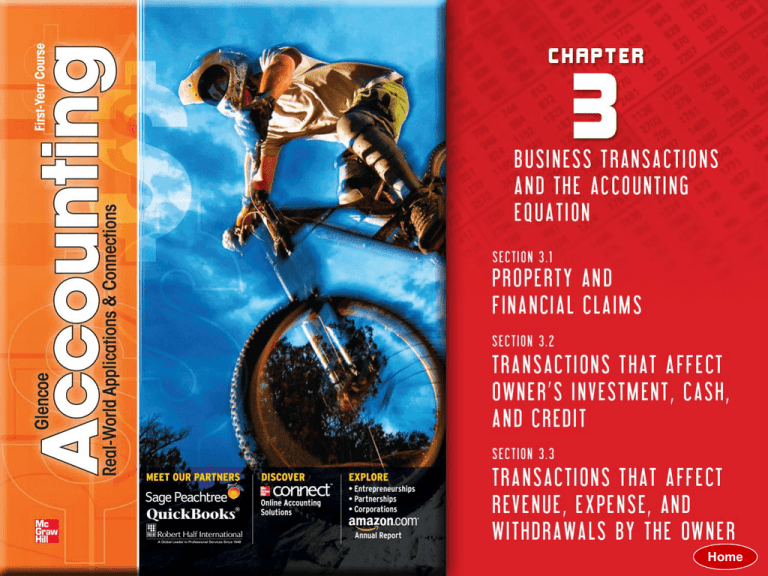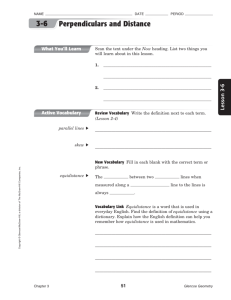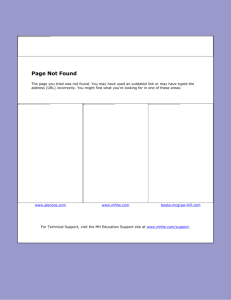
Home
Any item of property has at least one
financial claim against it. Accounts
are used to analyze business
transactions. Owner’s equity is
changed by revenue, expenses, and
withdrawals.
Home
Glencoe Accounting
Copyright © by The McGraw-Hill Companies, Inc. All rights reserved.
Describe the relationship between property and financial claims
Explain the meaning of the term equities as it is used in accounting.
List and define each part of the accounting equation.
Learn how businesses use accounts.
Demonstrate the effects of transactions on the accounting equation.
Check the balance of the accounting equation after a business
transaction has been analyzed and recorded.
Home
Glencoe Accounting
Copyright © by The McGraw-Hill Companies, Inc. All rights reserved.
Section 3.1
Property and
Financial Claims
Key Terms
property
assets
financial claim
equity
credit
owner’s equity
creditor
liabilities
Home
Glencoe Accounting
Copyright © by The McGraw-Hill Companies, Inc. All rights reserved.
Property
Section 3.1
Property and
Financial Claims
Financial information about
property
The purpose of
accounting is to provide:
Financial claim to property
property
Anything of value that a
person or business owns.
financial claim
A legal right to
property.
Home
Glencoe Accounting
Copyright © by The McGraw-Hill Companies, Inc. All rights reserved.
Property
Section 3.1
Property and
Financial Claims
Property
=
Financial
Claims
Home
Glencoe Accounting
Copyright © by The McGraw-Hill Companies, Inc. All rights reserved.
Property
Section 3.1
Property and
Financial Claims
A creditor lends you money.
The financial claim
is shared.
You buy something on credit.
credit
When you buy something and
agree to pay for it later.
creditor
Any person or business to which
you owe money.
Home
Glencoe Accounting
Copyright © by The McGraw-Hill Companies, Inc. All rights reserved.
Property
Section 3.1
Property and
Financial Claims
Home
Glencoe Accounting
Copyright © by The McGraw-Hill Companies, Inc. All rights reserved.
Financial Claims in
Accounting
Section 3.1
Property and
Financial Claims
Land
Buildings
Cash
Assets
Manufacturing
Equipment
assets
Property or items of
value owned by a
business.
Office
Equipment
Home
Glencoe Accounting
Copyright © by The McGraw-Hill Companies, Inc. All rights reserved.
Financial Claims in
Accounting
Section 3.1
Property and
Financial Claims
Equity
equity
The accounting term for the
financial claim to assets.
Owner’s
Equity
owner’s equity
The owner’s claim to the
assets of a business.
Home
Glencoe Accounting
Copyright © by The McGraw-Hill Companies, Inc. All rights reserved.
Financial Claims in
Accounting
Section 3.1
Property and
Financial Claims
The Accounting Equation
liabilities
Amounts owed to creditors; the
claims of creditors to the assets of
a business.
Home
Glencoe Accounting
Copyright © by The McGraw-Hill Companies, Inc. All rights reserved.
Section 3.2
Transaction That Affect Owner’s
Investment, Cash, and Credit
Key Terms
business transaction
account
accounts receivable
accounts payable
investment
on account
Home
Glencoe Accounting
Copyright © by The McGraw-Hill Companies, Inc. All rights reserved.
Business Transactions
Section 3.2
Transaction That Affect Owner’s
Investment, Cash, and Credit
Buying a sweater or putting cash in
your savings account are examples of
business transactions.
business transaction
An economic event that causes a
change—either an increase or
decrease—in assets, liabilities, and/or
owner’s equity.
Home
Glencoe Accounting
Copyright © by The McGraw-Hill Companies, Inc. All rights reserved.
Business Transactions
Section 3.2
Transaction That Affect Owner’s
Investment, Cash, and Credit
Accounts receivable
A business records changes
in subdivisions called
accounts.
Accounts payable
account
A subdivision under assets, liabilities, or
owner’s equity.
Home
Glencoe Accounting
Copyright © by The McGraw-Hill Companies, Inc. All rights reserved.
Business Transactions
Section 3.2
Transaction That Affect Owner’s
Investment, Cash, and Credit
Accounts receivable
A business records changes
in subdivisions called
accounts.
accounts receivable
The total amount of money owed to a
business—money to be received later
because of the sale of goods or
services on credit.
Accounts payable
accounts payable
The amount owed, or
payable, to the
creditors of a
business.
Home
Glencoe Accounting
Copyright © by The McGraw-Hill Companies, Inc. All rights reserved.
Business Transactions
Section 3.2
Transaction That Affect Owner’s
Investment, Cash, and Credit
Steps for
analyzing a
business
transaction
2
1
4
3
Make sure the accounting equation
remains in balance.
Determine the amount of increase or
decrease for each account affected.
Classify the accounts affected.
Identify the accounts affected.
Home
Glencoe Accounting
Copyright © by The McGraw-Hill Companies, Inc. All rights reserved.
Transactions and the
Accounting Equation
Section 3.2
Transaction That Affect Owner’s
Investment, Cash, and Credit
Analyze a cash investment transaction:
Business Transaction 1
Christa Vargas took $25,000 from personal savings and deposited that amount
to open a business checking account in the name Zip Delivery Service.
See page 58
investment
Money or other property paid out in order to produce a profit.
Home
Glencoe Accounting
Copyright © by The McGraw-Hill Companies, Inc. All rights reserved.
Transactions and the
Accounting Equation
Section 3.2
Transaction That Affect Owner’s
Investment, Cash, and Credit
Business Transaction 2
Christa Vargas transferred two telephones valued at $200 each from her home
to the business.
See page 59
Home
Glencoe Accounting
Copyright © by The McGraw-Hill Companies, Inc. All rights reserved.
Transactions and the
Accounting Equation
Section 3.2
Transaction That Affect Owner’s
Investment, Cash, and Credit
Analyze a cash purchase business transaction:
Business Transaction 3
Zip issued a $3,000 check to purchase a computer system.
See page 59
Home
Glencoe Accounting
Copyright © by The McGraw-Hill Companies, Inc. All rights reserved.
Transactions and the
Accounting Equation
Section 3.2
Transaction That Affect Owner’s
Investment, Cash, and Credit
Analyze a purchase on account business transaction:
Business Transaction 4
Zip bought a used truck on account from Coast to Coast Auto for $12,000.
on account
When a business buys an item on credit.
See page 60
Home
Glencoe Accounting
Copyright © by The McGraw-Hill Companies, Inc. All rights reserved.
Section 3.3
Transaction That Affect
Revenue, Expense, and
Withdrawals by the Owner
Key Terms
revenue
expense
withdrawal
Home
Glencoe Accounting
Copyright © by The McGraw-Hill Companies, Inc. All rights reserved.
Revenue and Expense
Transactions
Section 3.3
Transaction That Affect
Revenue, Expense, and
Withdrawals by the Owner
Examples of Revenue
Fees earned for services performed
Cash received from the sale of merchandise
revenue
Income earned from the sale of goods
or services.
Home
Glencoe Accounting
Copyright © by The McGraw-Hill Companies, Inc. All rights reserved.
Revenue and Expense
Transactions
Section 3.3
Transaction That Affect
Revenue, Expense, and
Withdrawals by the Owner
Examples of Expenses
Rent
Utilities
Advertising
expense
The cost of products or services used to operate a business.
Home
Glencoe Accounting
Copyright © by The McGraw-Hill Companies, Inc. All rights reserved.
Withdrawals by the Owner
Section 3.3
Transaction That Affect
Revenue, Expense, and
Withdrawals by the Owner
Withdrawals decrease
assets and owner’s equity.
Investments increase
assets and owner’s equity.
withdrawal
When the owner takes cash or other assets from the business for personal use.
Home
Glencoe Accounting
Copyright © by The McGraw-Hill Companies, Inc. All rights reserved.
Question 1
O’Donnell’s Car Wash has the following assets and liabilities.
Assets: Cash in Bank $9,500; Accounts Receivable $500; Computer
Equipment $3,500; Car Wash Equipment $75,000; Building $450,000
Liabilities: Alto’s Equipment Service $2,500;
First National Bank (mortgage on building) $200,000
What is the owner’s equity for O’Donnell’s?
Step 1
Calculate total assets.
$9,500 + $500 + $3,500 + $75,000 + $450,000 = $538,500
Step 2
Calculate total liabilities.
$2,500 + $200,000 = $205,500
Step 3
Calculate owner’s equity.
$538,500 - $202,500 = $336,000
Home
Glencoe Accounting
Copyright © by The McGraw-Hill Companies, Inc. All rights reserved.
Question 2
A business owner invests $12,000 cash in the business.
How would you analyze this transaction?
1.
Identify the accounts affected.
a. Cash in Bank is affected.
b. Owner’s Capital is affected.
2.
Classify the accounts affected.
a. Cash in Bank is an asset account.
b. Owner’s Capital is an owner’s equity account.
3.
Determine the amount of increase or decrease for each
account affected.
a. Cash in Bank is increased by $12,000.
b. Owner’s Capital is increased by $12,000.
4.
Home
Glencoe Accounting
Make sure the accounting equation remains in balance.
Assets = Liabilities + Owner’s Equity
$12,000 =
0
+ $12,000
Copyright © by The McGraw-Hill Companies, Inc. All rights reserved.
End of
Home




